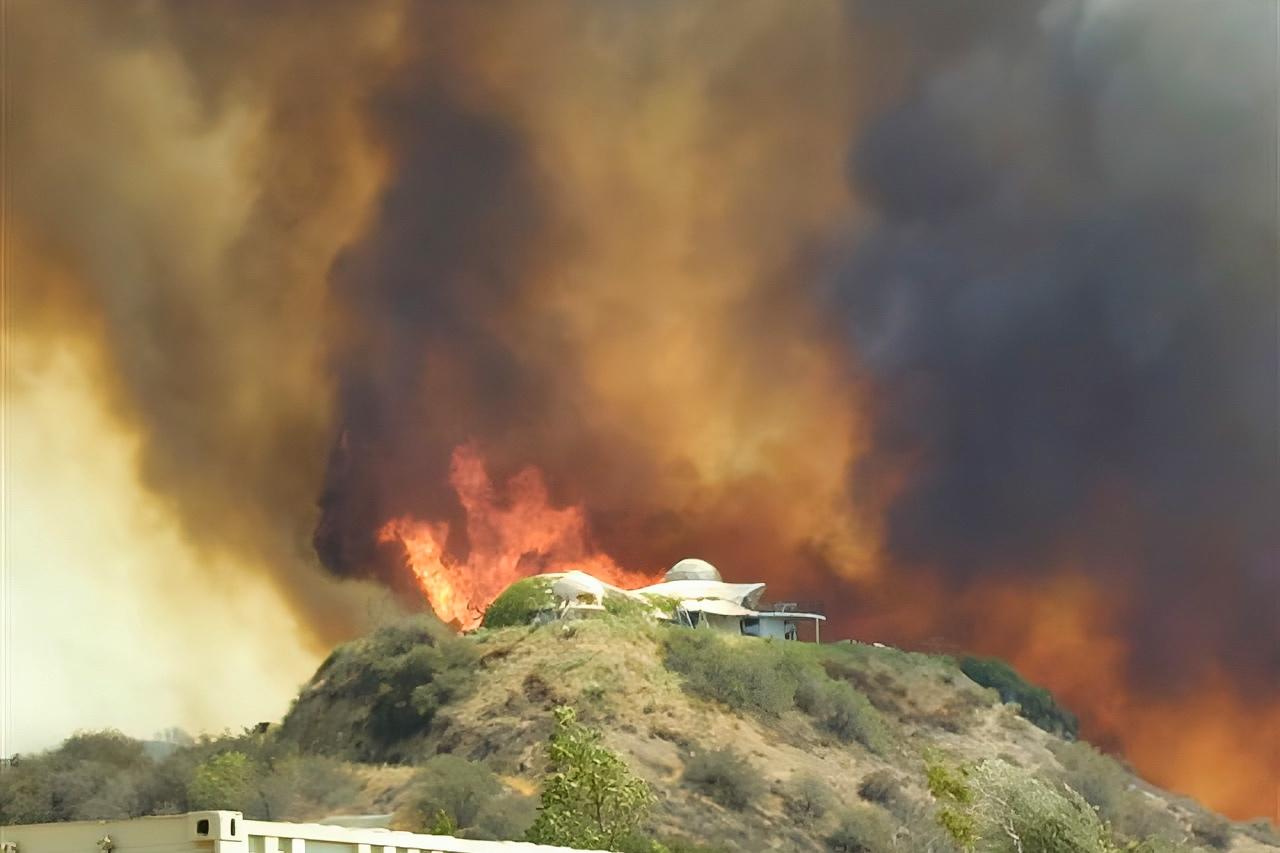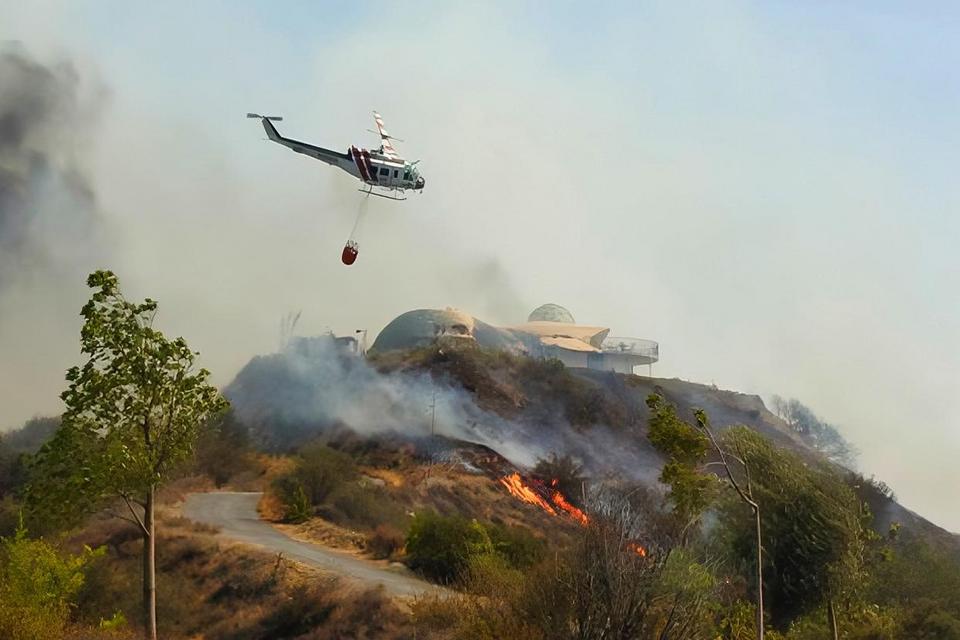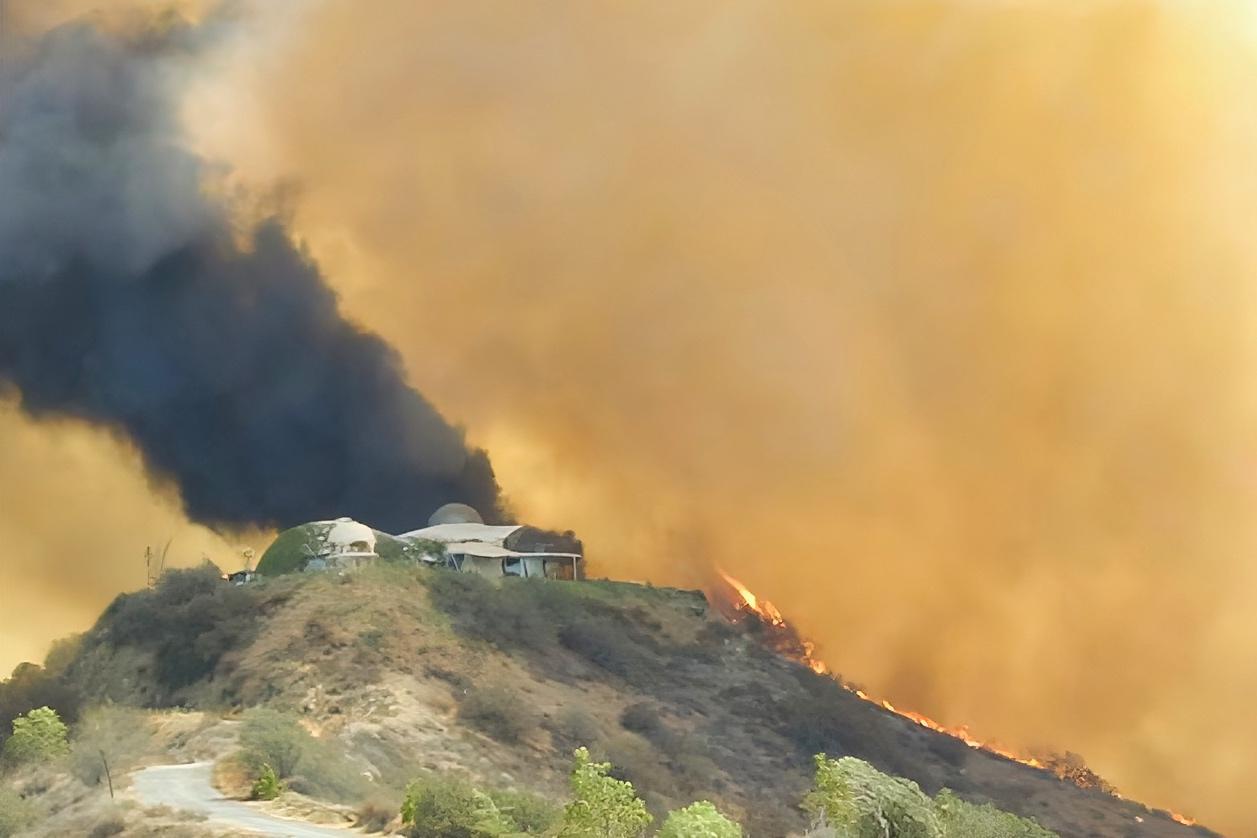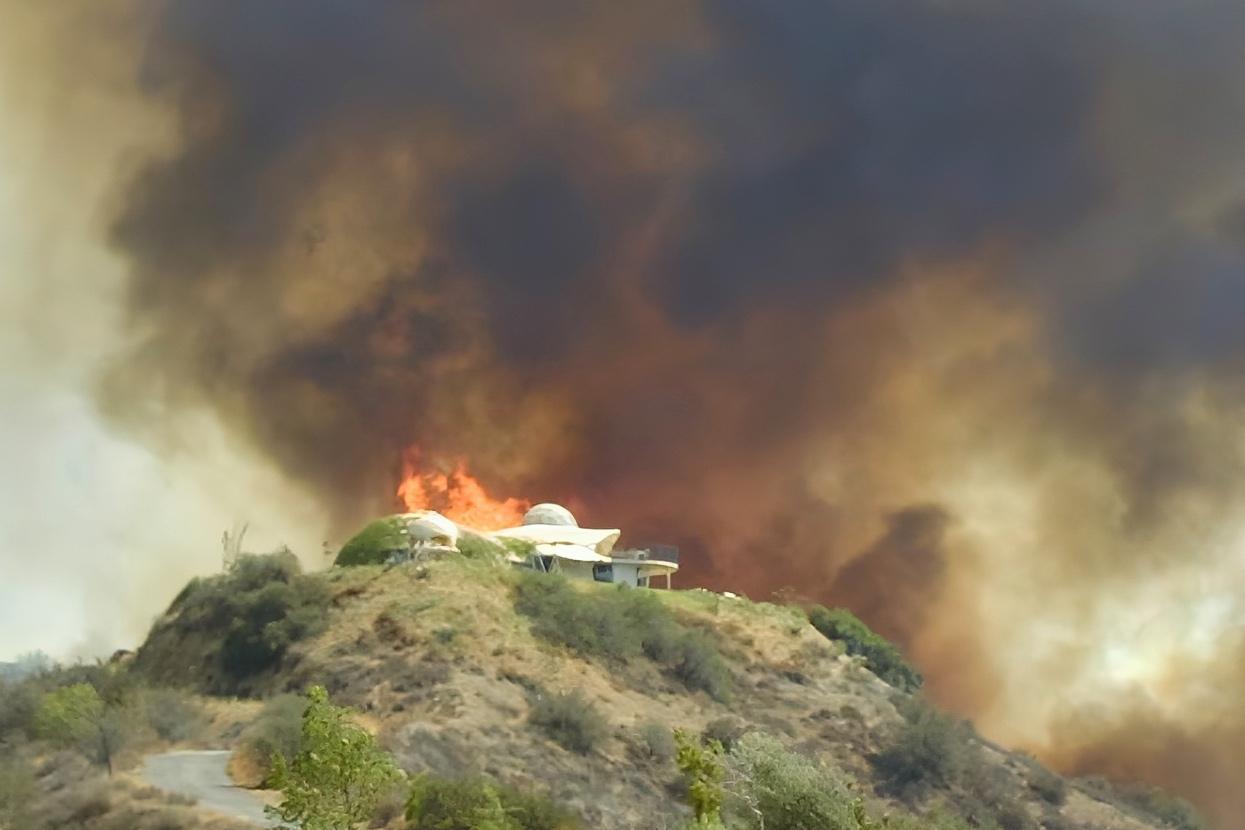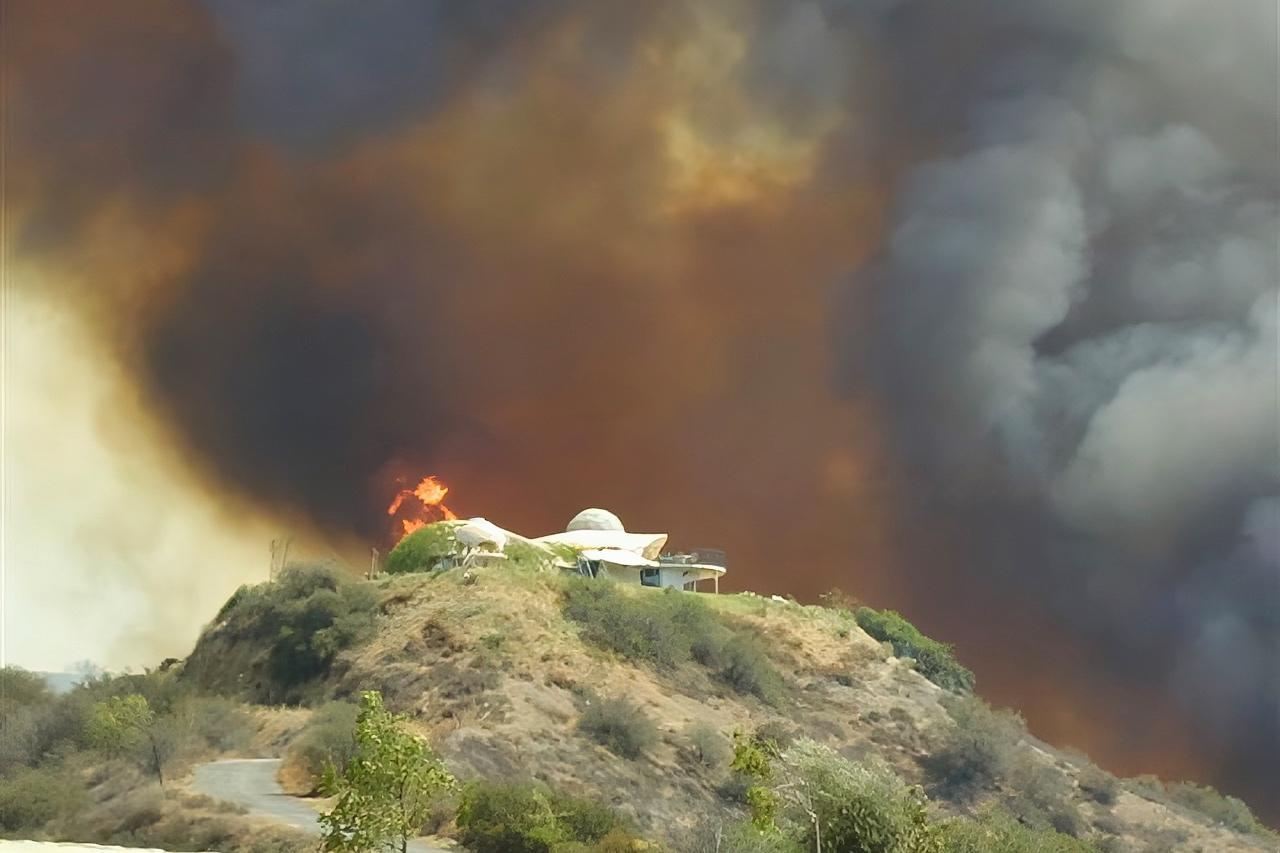Burning Legacy: How Vista Dhome Defied an Inferno
What should have been a quiet, ordinary Sunday-in-August afternoon for Ruth and Al Braswell wasn’t. In fact, it was anything but that—all because of one troubled, 16-year-old boy who allegedly started a brush fire in an olive grove at the end of Bryant Street in Calamesa, California.
That olive grove sits only about a mile from Vista Dhome. Heat rose up to and above the 100-degree mark that hot, dry afternoon, so the fire spread rapidly. Within a short time, the Bryant Fire reached the surrounding wall and outlying buildings at the Braswell estate.
Al’s Story
Ruth and I were not home when the fire started. We were up in the mountains that weekend, raking dry leaves away from our cabin—ironically—to keep it safe from fire.
On our drive back, about a mile from home, we spotted the smoke. Then, we saw all the fire equipment, including a fire engine, in our driveway. I went over and said, “You guys are a welcome sight with that blaze down there.” A fire captain walked over to me and asked, “Are you the owner?”
I answered affirmatively, and he said, “You have two minutes to get what you want out of this house and get out of our way.” He was brusque—all business—but we understood, of course. We ran in, got a little file of current paperwork and some pictures and got out.
Ruth’s Story
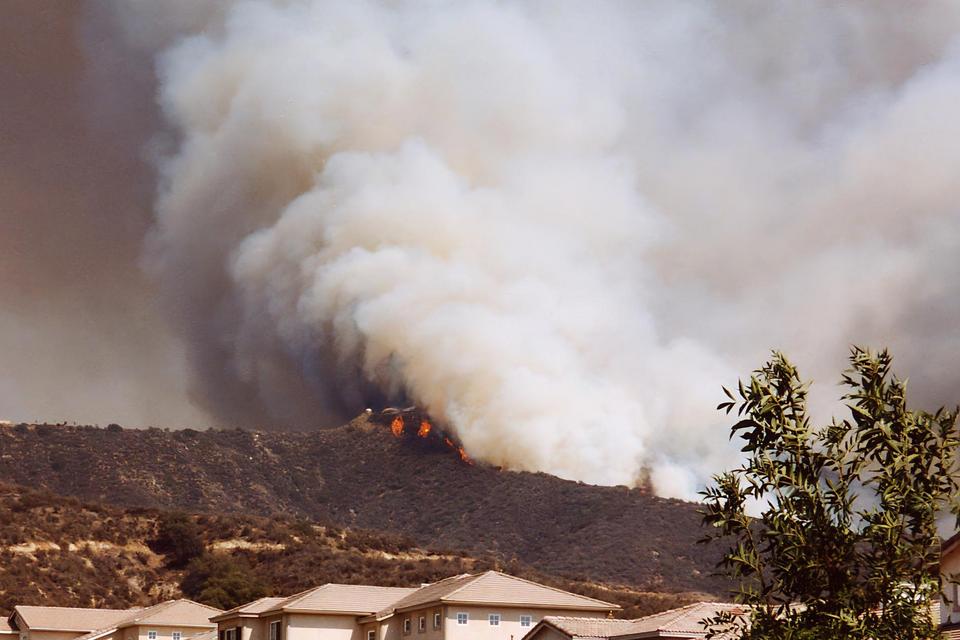
Firefighters and neighbors were surprised that the Braswell’s dome home survived the roaring flames, heat and smoke.
A fire captain from a neighboring county came over and asked, “What’s this thing (the dome) made of?” We told him, and he said, “Well, you do know that if this structure had been made of normal construction, you would have a pile of ashes now.”
He then told us that at one point, the firefighters thought they would have to abandon fighting and give up on saving our house. Then they saw that it could withstand the fire, so they decided that if any of their crew got in trouble, they were going to break the doors down and put the guys in the dome so they would be safe.
I said, “You would not have to break the doors down. I unlocked them all for you.” And they stuck it out. They had to move their trucks three times, but they did it.
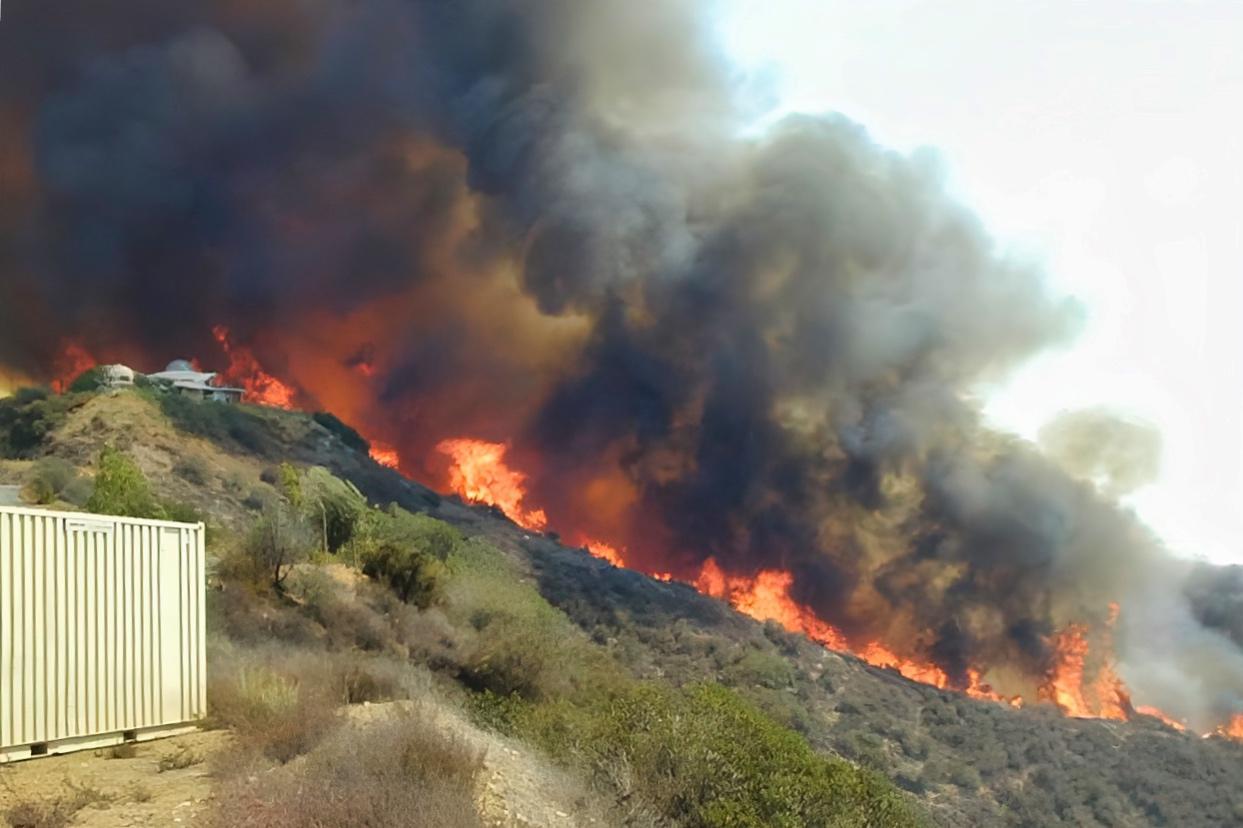
Vista Dhome is not the only Monolithic Dome home to have survived a fire, but it might be the most iconic.
Engulfing Flames
At the Braswells, the Bryant Fire first attacked a free-form, faux rock wall, about 30 feet long, built to conceal their swimming pool and protect pool equipment. The wall extended from the edge of their ridge to the garage.
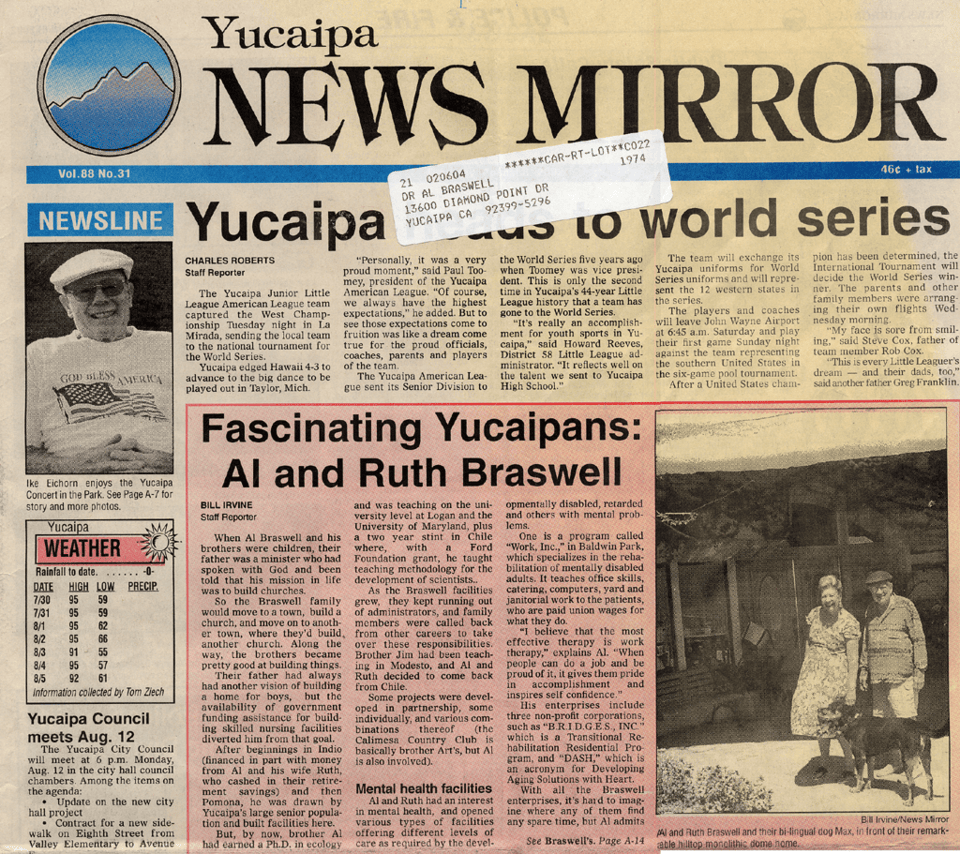
Al Braswell’s copy of the Yucaipa News Mirror. This issue featured a front-page story about him and his wife. The photo caption calls Vista Dhome a “remarkable hilltop Monolithic Dome home.”
Al said, “We had not yet stuccoed this wall. It was rebar in raw foam that was painted to preserve the foam but not really covered. The wall burned completely— leaving a tangled-looking mass of rebar—and it was what conducted the fire to the garage and then our home.
“We had added about an eight-foot foam extension onto the garage, so the garage door would be outside, rather than inside, the garage dome,” Al continued. "That extension was also raw foam, so it burned right up to the stucco of the dome.
“The fire went right over the top of our house, down the hill, and caught on the other side,” Al said. "We had vines covering most of the dome. The fire came from the west, so the vines burned completely on the dome’s west side and were badly damaged on the east side.
“I had an old oak snag (dead tree) with branches sticking up through the patio roof to give it a rustic look. The fire came over the dome and devoured that tree.”
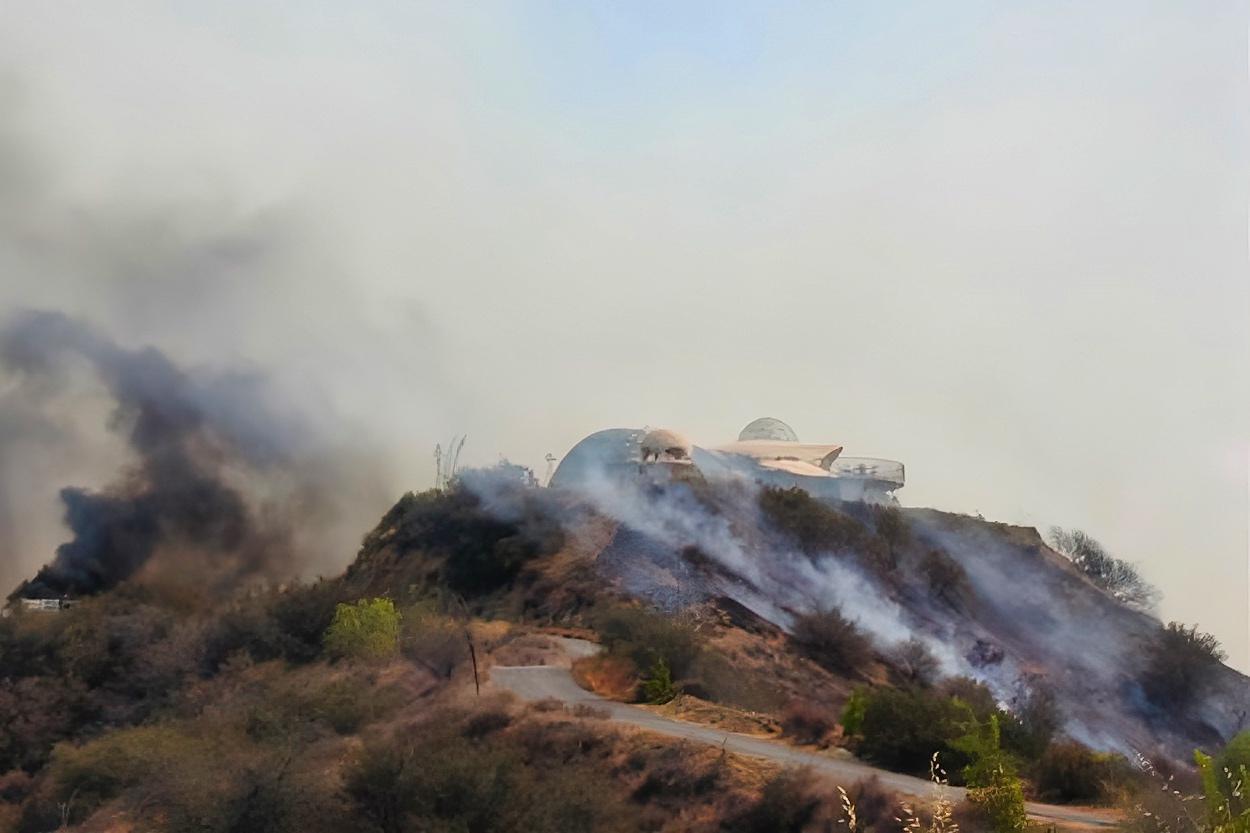
The Bryant Fire was terrifying, but 675 firefighters, 21 supervisors, 87 fire engines, 6 helicopters and 11 airplanes saved the area from greater destruction, and Vista Dhome stood strong.
Dome Survives
“That was a wild, wild fire,” Al concluded. “But it didn’t get our home.”
The Bryant Fire did, however, destroy the electrical box on the outside of the dome and cause smoke damage on the inside. Consequently, the Braswells could not live in Vista Dhome for more than six weeks after the fire while the electrical system was repaired, the painting completed, and the carpeting replaced.
Additional losses for the Braswells included three antique vehicles, a foam machine, a compressor, a utility trailer and miscellaneous equipment, for an estimated total of about $300,000.
The Total Picture
According to the Riverside County Fire Department, the Bryant Fire destroyed 550 acres of hillside, threatened about 250 dwellings and 15 outbuildings, and prompted 150 residents to abandon their homes voluntarily.
It took 675 firefighters, 21 supervisors, 87 engines, 26 hand crews, 2 bulldozers, 6 water helicopters, 11 airplanes dropping fire retardant, more than 24 hours of intense fire fighting and an additional 2 days of cooling hot spots to finally extinguish the Bryant Fire. In the process, several firefighters required treatment for heat sickness and knee and ankle injuries. Estimated cost of damages: $2.5 million.
How Fire-Susceptible Is Polyurethane Foam?
I first heard about the Bryant Fire from Barry, Ruth and Al Braswells’ son, Barry, a few weeks after it happened. Barry described the fire’s magnitude and stressed how delighted they were with the dome’s ability to withstand those flames. I was not surprised to learn that the dome won the battle.
As for the polyurethane foam, it burned because it had no covering. If the foam had had a fire-proof barrier, such as 3/4” of stucco, it’s very unlikely that there would have been enough fire to cause any damage. Urethane foam either burns really well or does not burn.
The Bryant fire must have reached 750 to 1000 degrees F in order to have ignited the foam. The foam won’t support combustion by itself. Its kindling point is about 750 degrees F.
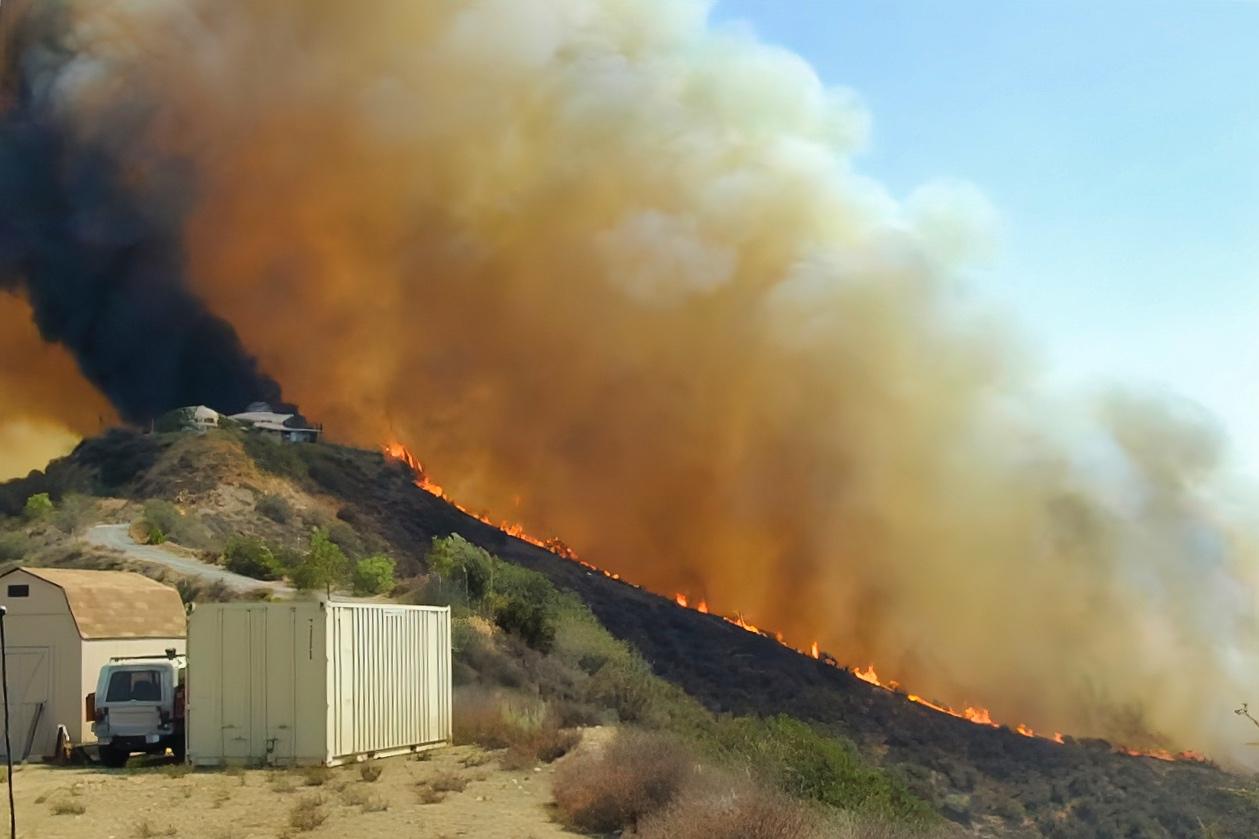
A fire chief told the Braswells that if their dome had been a conventional house, it would have burned into a “pile of ashes.”
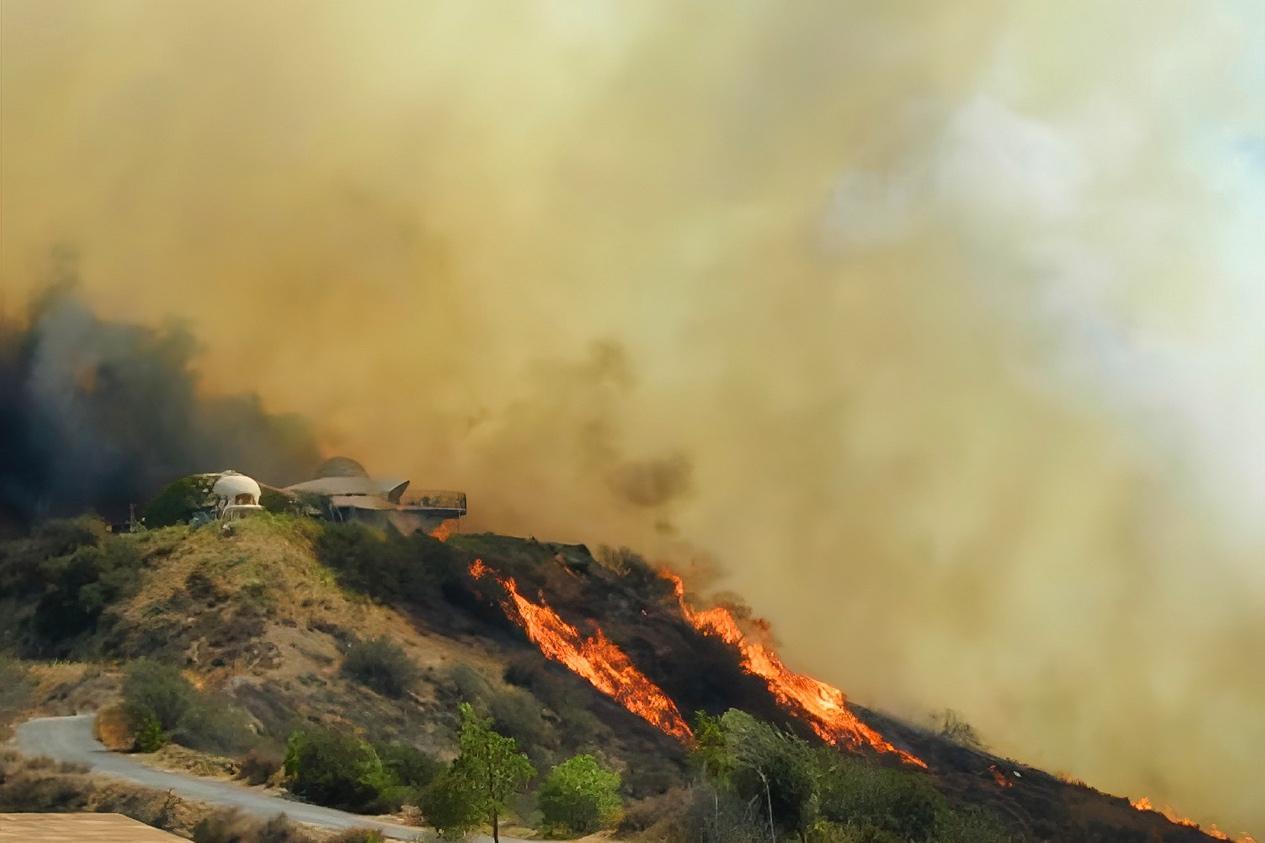
The Braswells were given just a few minutes to remove some valuables and paperwork from the home before evacuating.
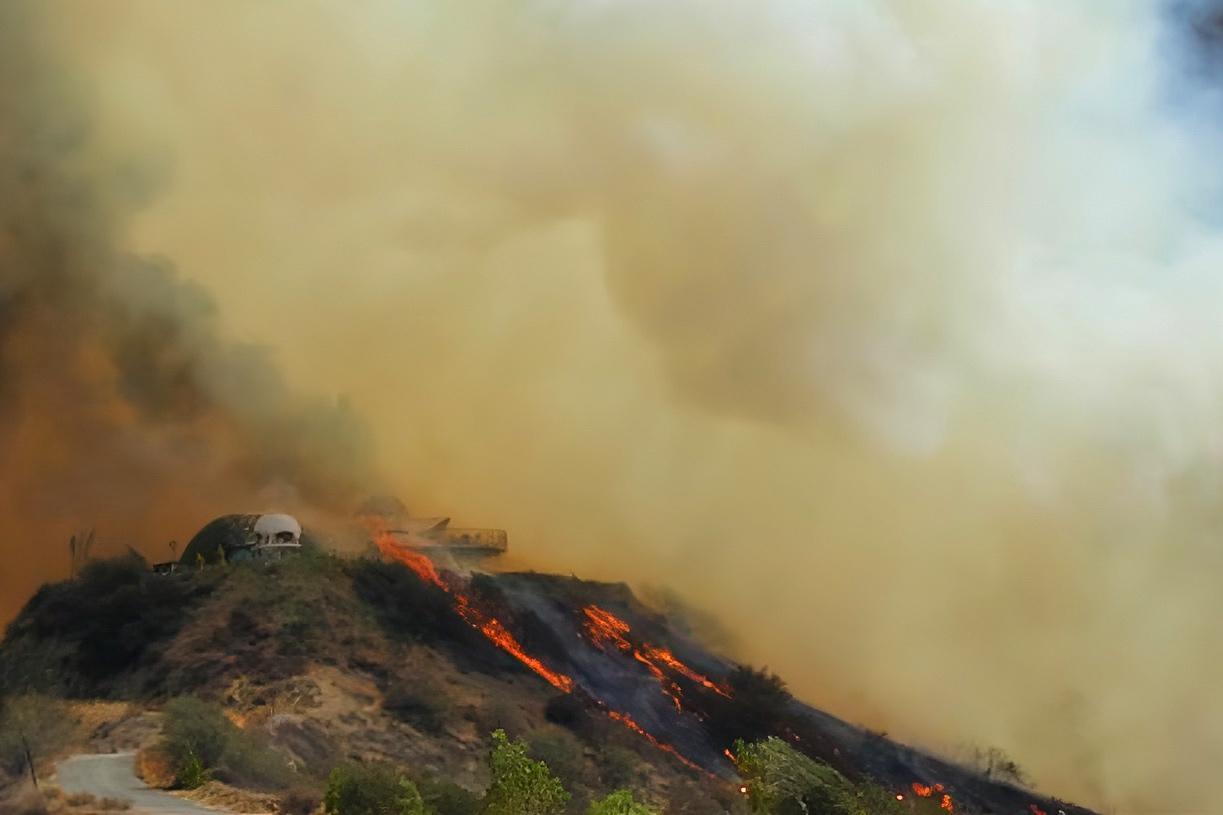
The Braswells were clearing the area around their cabin—a fire safety measure—when the Bryant Fire started not far from their home.
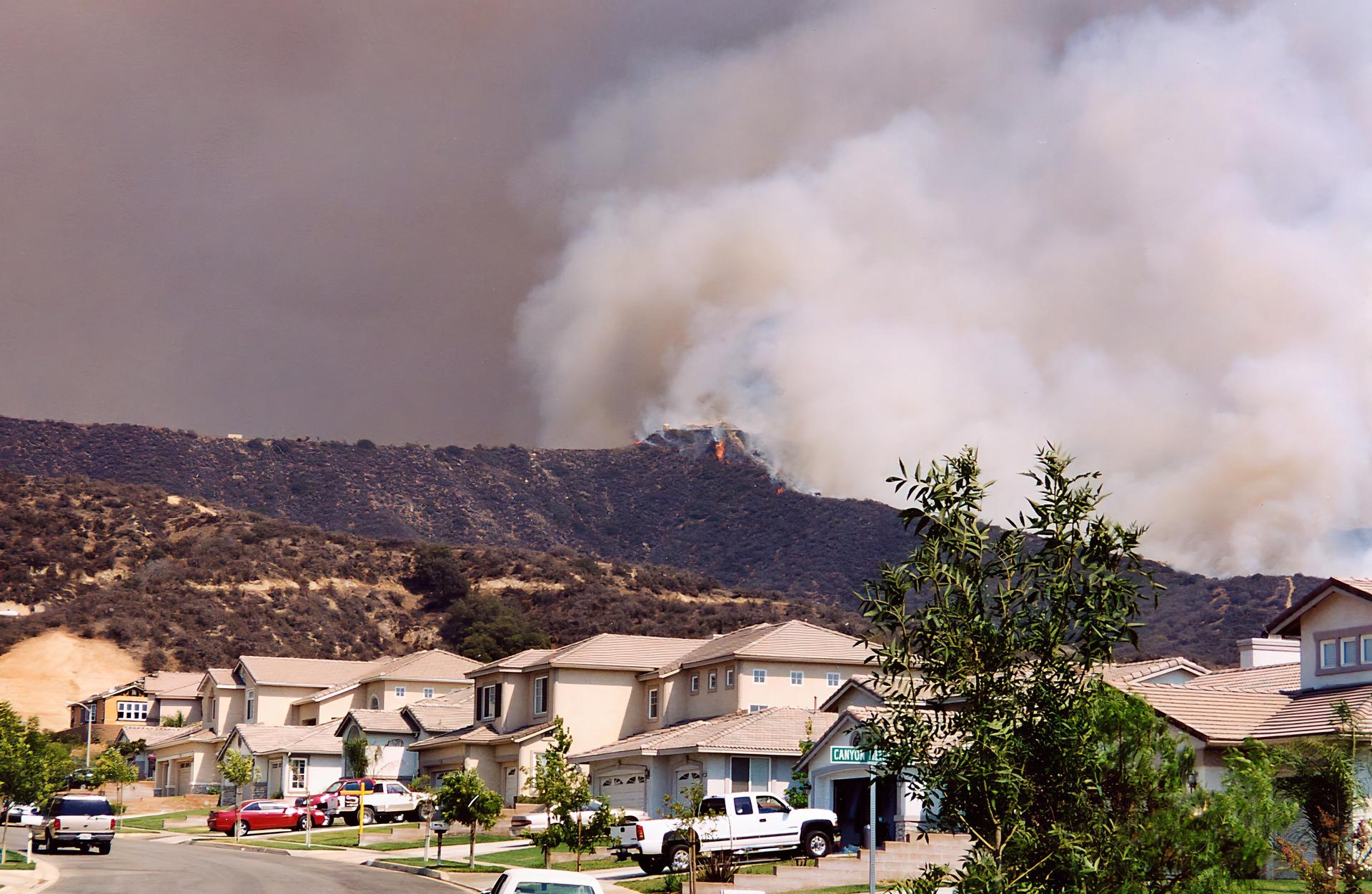
Ruth Braswell was told that the firefighters thought they would have to evacuate at one point. Then, they saw the dome could withstand the fire, so they decided that if they had to, they would take cover inside the home. Ruth had had the same idea earlier, and had left the doors unlocked for them.
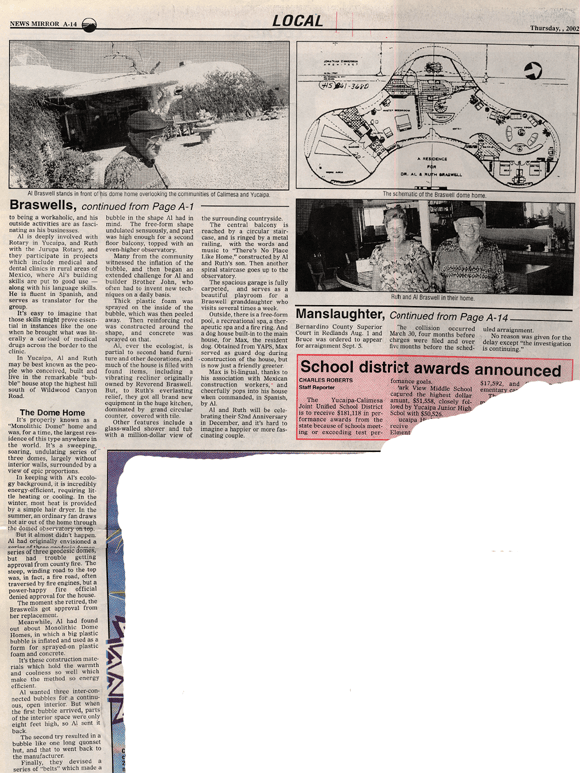
The article in this issue of the Yucaipa News Mirror calls the Braswell’s home a “sweeping, soaring, undulating series of three domes.”
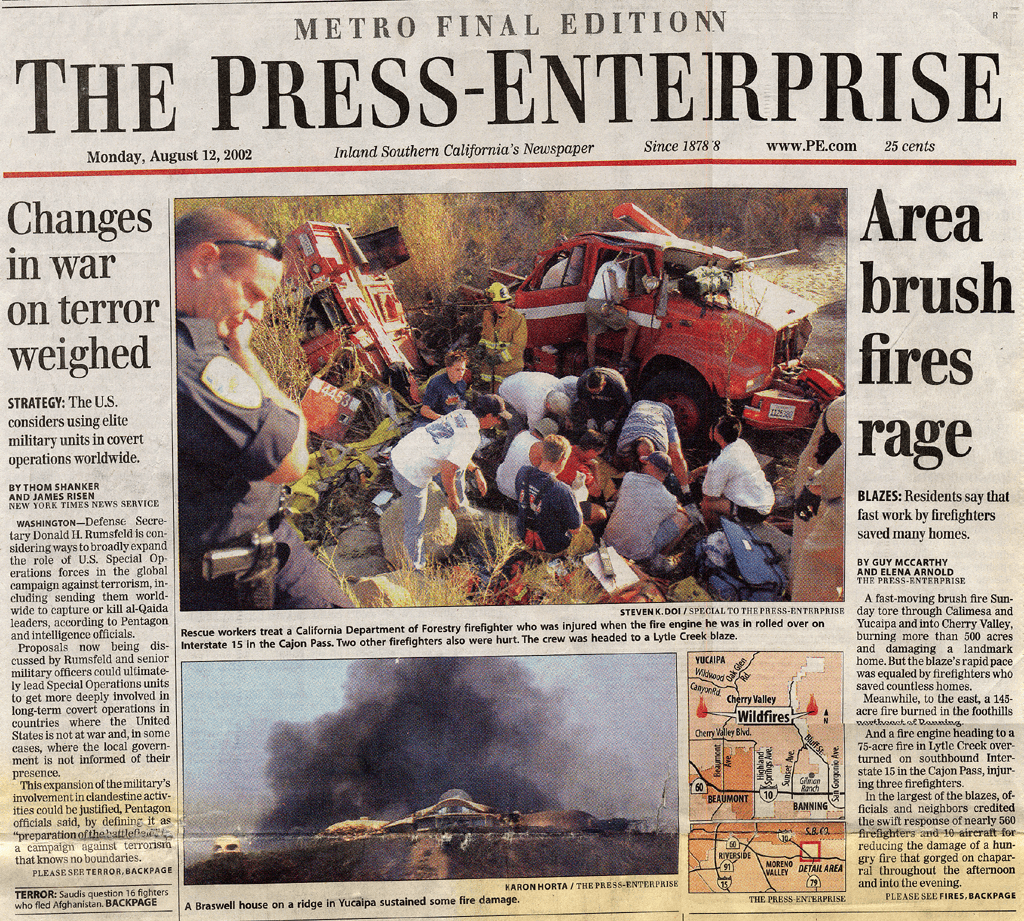
The front page of the Metro Final Edition of the Press-Enterprise on Monday, August 12, 2002, had a story about the heroic actions of firefighters fighting area brush fires and featured a large photo of Vista Dhome.
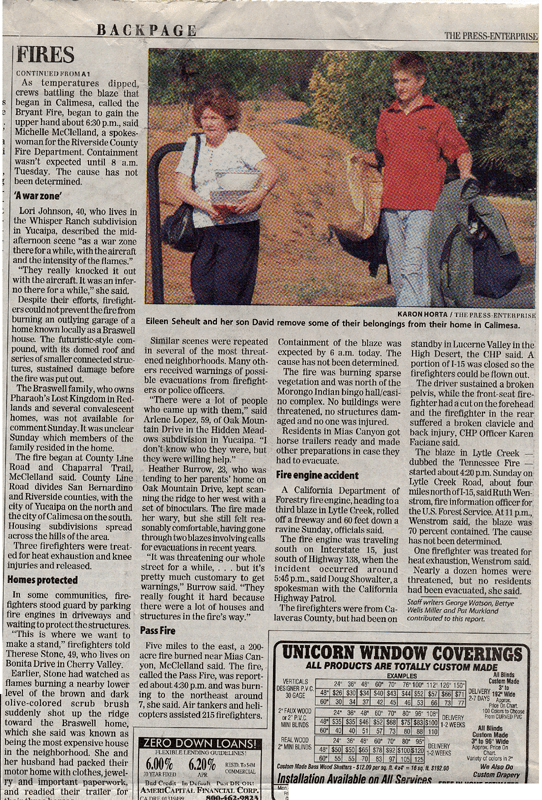
The Press-Enterprise article mentions Vista Dhome a few times, calling it a “futuristic style compound” and quotes a neighbor as saying the Braswell’s house was known as “the most expensive house in the neighborhood.”
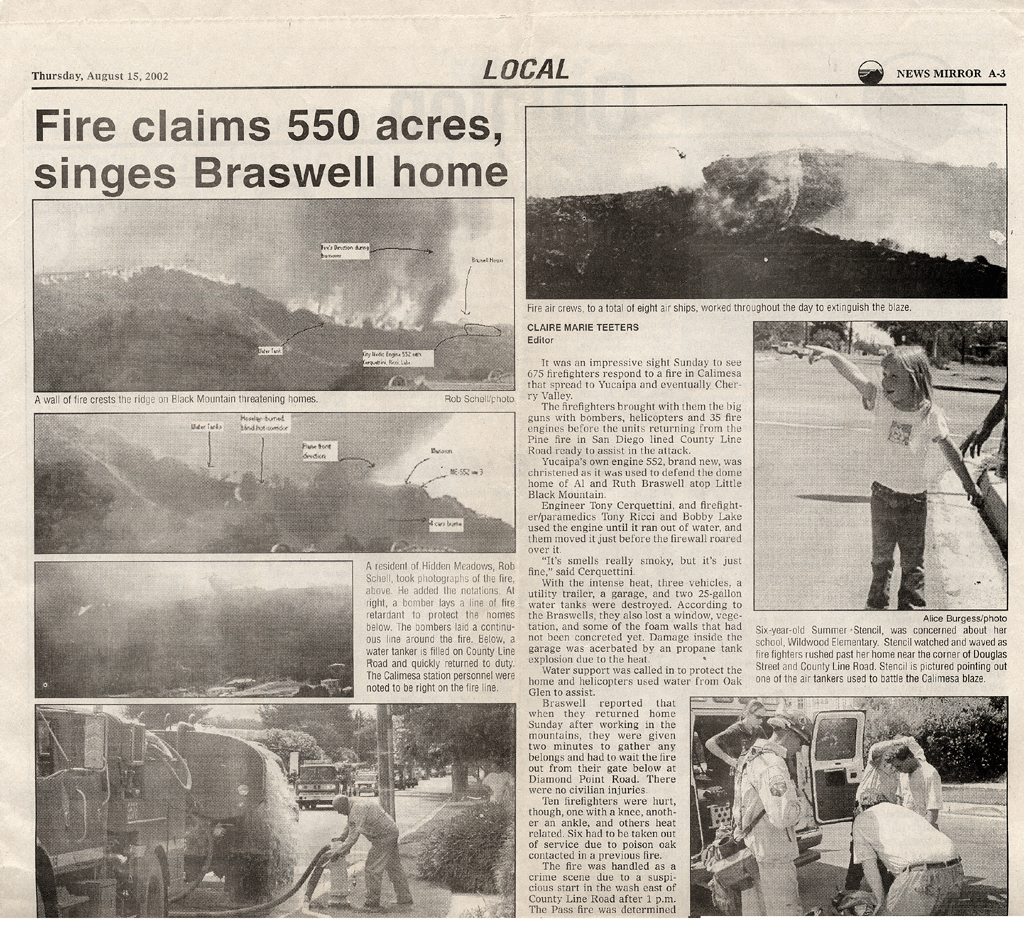
The Yucaipa News Mirror printed another story covering the Bryant Fire, featuring more information about the Braswell’s house, including photos of the fire burning toward and over the top of Vista Dhome.
